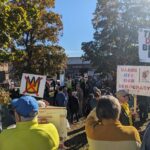
In New Mexico, the Regional Farm to Food Bank program (RF2FB), created under the 2021 American Rescue Plan Act, provided contracts to over 200 farmers, ranchers, and other food producers to support locally sourced food. The 900,000 pounds of food they sold helped provide 749,502 healthy meals for the most vulnerable people in New Mexico. These sustainable contracts also helped small and midsize producers grow and scale up for the upcoming growing seasons.
The US Department of Agriculture’s (USDA’s) termination of the Local Food Purchase Assistance Cooperative Agreement Program (LFPA) will not only impact New Mexico’s RF2FB program but all similar programs across the nation, which will be imperiled—or altogether abandoned—because of these funding cuts.
Programs such as sourcing food from local farmers for food banks and public schools, which built resiliency across food systems infrastructure, will likely not survive without federal funding. Expanded economic opportunities for local producers, which struggle to compete with industrial farming, will also be curtailed. In rural communities the losses will be especially acute.
Hardships in Rural Areas
Being swept up in a “one-billion-dollar USDA cut” means “we’ve lost approximately 120,000 pounds of high-quality local food.”
In Midwestern states like Wisconsin, USDA programs have provided a safety net that has allowed small farmers to help take care of extended networks, from fellow retired farmers to their grandchildren.
Padraig Gallagher is director of the nonprofit Feed My People Food Bank, which serves 14 Wisconsin counties, 13 of them rural. He noted in an interview with NPQ that the problem is not only the cuts and the growing need for food banks, it’s being heard over political rhetoric.
As Gallagher pointed out, it’s hard to address the actual issues at hand because of “the political lines that are primed to interpret anything we do as maybe it’s us being on the other side of some imaginary line of opposition, you know, as we’re trying to highlight problems which are objective problems.”
Being swept up in a “one-billion-dollar USDA cut” means “we’ve lost approximately 120,000 pounds of high-quality local food,” Gallagher added.
Corrisa Villeneuve, director of a Stepping Stones food bank in Menomonie, WI, which also provides “pop-up pantries” in other towns, stressed to NPQ that the cuts have been especially hard on rural areas: “I know that in many ways Stepping Stones is not unique. I’ve heard from quite a few food banks and shelters across the country who are having the same issue, especially in, it seems like, more rural areas where they relied a lot on the Farm to Food Bank programs.”
And while Stepping Stones had long cultivated relationships with local farmers before the introduction of the LFPA, the program allowed the pantry to address more food insecurity while supporting farmers as well as forging relationships with new farmers.
The organization is already seeing the impacts of the loss of the program; they had to reduce hours for its staff and no longer offers Friday food distribution.
Food banks and farmers alike are less able to manage the potential increase in the number of people needing their help.
Impacts on Children and Seniors
The loss of these Friday food bank visits will impact the most vulnerable. Stepping Stones food pantry distributor John Gardner noted that many of those who come through the line for food are under 18 or over 65.
This squares with national statistics. Over 7 million seniors and over 13 million children were food insecure in 2022.
These rates have risen in recent years as the COVID-19 pandemic caused more families to be food insecure and rely on food banks. The USDA cuts come against a backdrop of global disruption to the food supply due to tariffs and wars, which have introduced more uncertainty for farmers and further compounded food insecurity. Proposed cuts to SNAP seem poised to make many millions more food insecure as food costs are once again expected to rise above many people’s wages.
Taken together, these factors indicate that food banks and farmers alike are less able to manage the potential increase in the number of people needing their help.
A Tenuous and Tight Moment
At the national level, US Senator Ben Ray Luján (D-NM) told Source New Mexico that the RF2FB program is “an essential program that was agreed to in a bipartisan way over the last few years, understanding the need across America when it came to access to food and the problem with hunger.”
In Wisconsin, Republican Representative Derrick Van Orden has argued in town halls that vital programs like the LFPA will return on some level.
“There’s going to be help on the way,” he said.
One answer may look like states instituting their own versions of the LFPA, like the Choose Iowa program or the Texas’s Farm to School and Farm to Food Bank programs.
“We don’t want to see our suppliers have to become our users.”
The problem is that many small and midsize farmers rely not only on one grant like the LFPA but on many. For example, a farmer may have received only 10 percent of their income from the LFPA, but also depended on funding from similar programs like the Resilient Food Systems Infrastructure Grant and the Rural Energy for America Program.
Moreover, rural areas also depend on the federal government for crucial roles impacting the food supply, such as food inspectors. Such staff have also seen massive cuts. And even as Secretary of Agriculture Brooke Rollins has been able to push through economic assistance in the form of commodity payments, these are often more accessible to larger farms.
As organic farmer Zoe Bradbury DeSurra told the Statesman Journal: “It’s kind of a tenuous and tight moment when you’re already working with pretty small profit margins and you spend all that you have, or dip into savings, or borrow some money, or just foot the bill and then don’t get paid back.”
Or, as Gallagher noted, “We don’t want to see our suppliers have to become our users.”
For More on This Topic
Farmers Are Finally Getting Critical USDA Web Pages Back
From Food Pantry to Urban Farming: Food Justice Lessons from Camden














